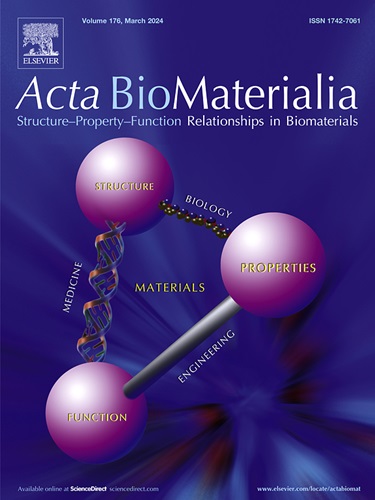双心室心力衰竭绵羊三尖瓣小叶重构:小叶的比较。
IF 9.4
1区 医学
Q1 ENGINEERING, BIOMEDICAL
引用次数: 0
摘要
三尖瓣小叶是动态组织,可以对改变的生物力学和血流动力学负荷作出反应。每个小叶有独特的结构和机械性能,导致不同的体内菌株。我们假设这些内在差异驱动了小叶之间异质性的、疾病诱导的重塑。虽然我们之前报道了前小叶的显著重塑变化,但其他两个小叶的反应尚未报道。使用羊双心室心力衰竭模型,我们比较了所有三尖瓣小叶之间的重塑反应。我们的研究结果表明,前小叶发生了最显著的重塑,而间隔和后小叶表现出相似但不太明显的变化。我们发现在关键的结构和力学指标的几个小叶之间的差异已被证明有助于瓣膜功能障碍。患病动物表现为间隔小叶和前小叶明显变大,前后小叶变厚,前小叶变硬。室间隔小叶的各向异性指数显著降低。心房表面附近的间隔和前小叶胶原纤维弥散增加。在重塑标志物方面,α-平滑肌肌动蛋白(α-SMA)、Ki67、基质金属蛋白酶13 (MMP13)和转化生长因子β -1 (TGF-β1)呈空间和叶依赖性上调。也就是说,我们观察到这些标记物在小叶间隔近环和腹部区域表达增加,在小叶前部腹部区域表达增加,在小叶后部表达不同。这些发现强调需要考虑小叶特异性重构,以充分了解三尖瓣功能障碍,并开发针对其治疗的靶向疗法和更准确的计算模型。意义声明:我们的研究具有重要意义,因为它通过提供对双心室心力衰竭羊模型中所有三个小叶的全面分析,提高了我们对三尖瓣重构的理解。与以往主要关注前小叶或广义小叶变化的工作不同,我们综合了形态学、组织学、免疫组织化学、双轴力学测试和双光子显微镜,在多个功能尺度上量化了所有三个三尖瓣小叶(前、后和间隔)之间的差异。这种综合的方法突出了每个小叶的独特的重塑反应。我们的发现为开发靶向治疗策略和改进疾病进展的计算模型提供了重要的见解。本文章由计算机程序翻译,如有差异,请以英文原文为准。

Tricuspid valve leaflet remodeling in sheep with biventricular heart failure: A comparison between leaflets
Tricuspid valve leaflets are dynamic tissues that can respond to altered biomechanical and hemodynamic loads. Each leaflet has unique structural and mechanical properties, leading to different in vivo strains. We hypothesized that these intrinsic differences drive heterogeneous, disease-induced remodeling between the leaflets. Although we previously reported significant remodeling changes in the anterior leaflet, the responses among the other two leaflets have not been reported. Using a sheep model of biventricular heart failure, we compared the remodeling responses between all tricuspid leaflets. Our results show that the anterior leaflet underwent the most significant remodeling, while the septal and posterior leaflets exhibited similar but less pronounced changes. We found several between-leaflet differences in key structural and mechanical metrics that have been shown to contribute to valvular dysfunction. Diseased animals exhibited significantly larger septal and anterior leaflets, thicker anterior and posterior leaflets, and stiffer anterior leaflets. Additionally, the septal leaflet's anisotropy index significantly decreased. Also, the septal and anterior leaflets showed increased collagen fiber dispersion near the atrial surface. As for remodeling markers, alpha-smooth muscle actin (αSMA), Ki67, matrix-metalloprotease 13 (MMP13), and transforming growth factor beta-1 (TGF-β1) were upregulated in spatially and leaflet-dependent patterns. That is, we observed increased expression of these markers within septal leaflets' near-annulus and belly regions, increased expression in anterior leaflets' belly region, and varied expression in posterior leaflets. These findings underscore the need to consider leaflet-specific remodeling to fully understand tricuspid valve dysfunction and to develop targeted therapies for its treatment and more accurate computational models.
Statement of significance
Our study is significant as it advances our understanding of tricuspid valve remodeling by providing a comprehensive analysis of all three leaflets in a sheep model of biventricular heart failure. Unlike prior works that focused primarily on the anterior leaflet or generalized leaflet changes, we integrated morphological, histological, immunohistochemistry, biaxial mechanical testing, and two-photon microscopy to quantify differences between all three tricuspid valve leaflets (anterior, posterior, and septal) across multiple functional scales. This comprehensive approach highlights the unique remodeling response of each leaflet. Our findings offer critical insights for developing targeted therapeutic strategies and improving computational models of disease progression.
求助全文
通过发布文献求助,成功后即可免费获取论文全文。
去求助
来源期刊

Acta Biomaterialia
工程技术-材料科学:生物材料
CiteScore
16.80
自引率
3.10%
发文量
776
审稿时长
30 days
期刊介绍:
Acta Biomaterialia is a monthly peer-reviewed scientific journal published by Elsevier. The journal was established in January 2005. The editor-in-chief is W.R. Wagner (University of Pittsburgh). The journal covers research in biomaterials science, including the interrelationship of biomaterial structure and function from macroscale to nanoscale. Topical coverage includes biomedical and biocompatible materials.
 求助内容:
求助内容: 应助结果提醒方式:
应助结果提醒方式:


